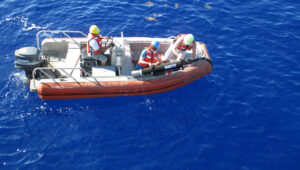Novel Use for a Familiar Instrument

In addition to salt, seawater contains a variety of other dissolved and particulate materials, such as sediment, organic materials, and living cells. Because of their varying sizes and compositions, each of these particles absorbs and reflects light differently. Oceanographers use this to their advantage—by shining a beam of light through the water and measuring how much light is absorbed or scattered, they can get an idea of the types and abundances of particles that are present.
For decades transmissometers have been used to accomplish this task, but Meg Estapa—Postdoctoral Investigator at Woods Hole Oceanographic Institution—is repurposing the instruments as optical sediment traps to investigate particle and carbon flux in the ocean. The vertical flux of particulate organic carbon (POC) from the surface waters to the deep ocean, also called the ocean’s “biological pump,” plays a significant role in how the atmosphere responds to increasing CO2 levels. As a result, scientists like Meg are keen to understand the rates at which particles deliver carbon through the water column to the deep ocean, and whether these rates display spatial or temporal variability.
When placed on neutrally buoyant autonomous floats, the transmissometers passively accumulate sinking particles on their optical windows, allowing Meg to measure particle flux at higher time resolution (compared to traditional sediment traps) and without requiring a research vessel, which can often be costly and can’t sample continuously. Over the past few months, she’s been visiting BIOS to conduct a calibration study comparing sediment flux measurements using sediment traps and transmissometers aboard bio-optical floats.
Her hope is that transmissometers will be shown to be effective platforms for making proxy measurements of carbon flux, which is the amount of carbon that settles out of a patch of ocean in a given time period. Meg is quick to point out that, if proven effective, “transmissometers could be added to the existing global array of Argo floats, dramatically increasing data coverage in terms of carbon flux and how the marine carbon cycle responds to climate change.”
